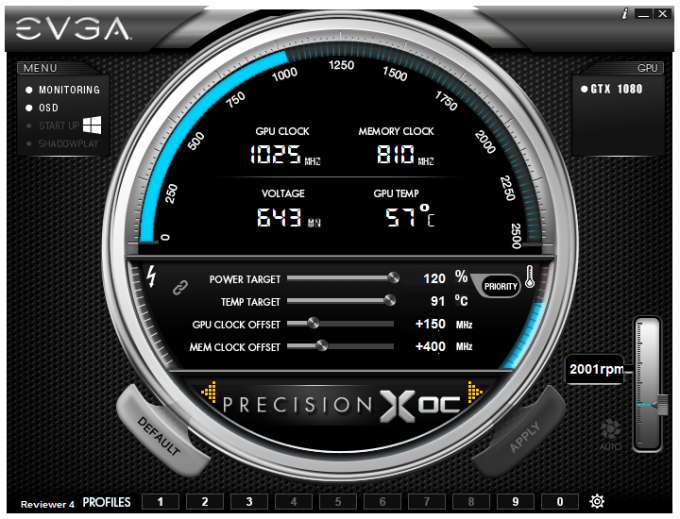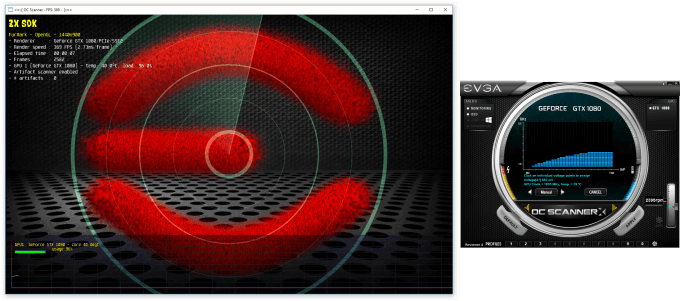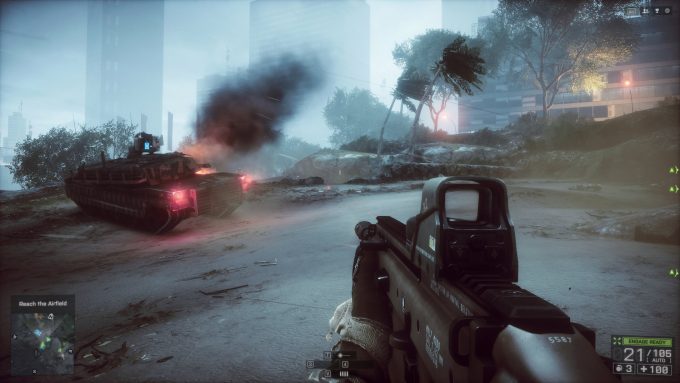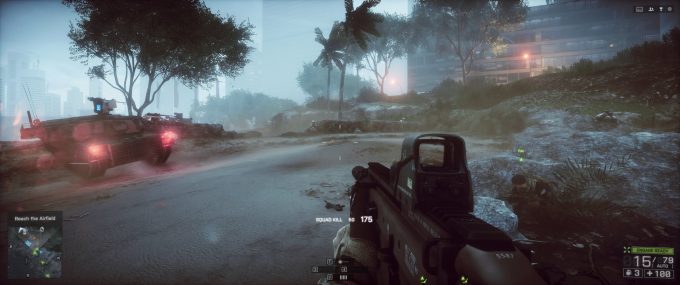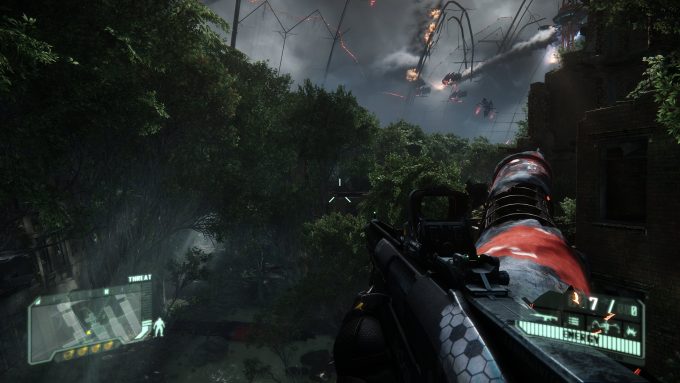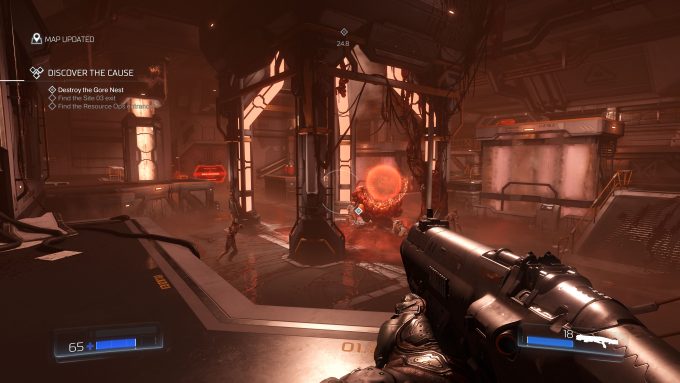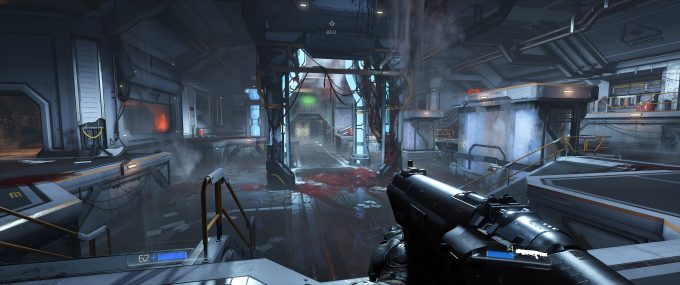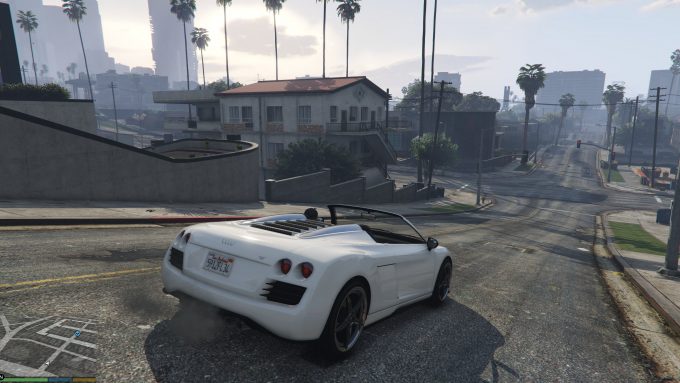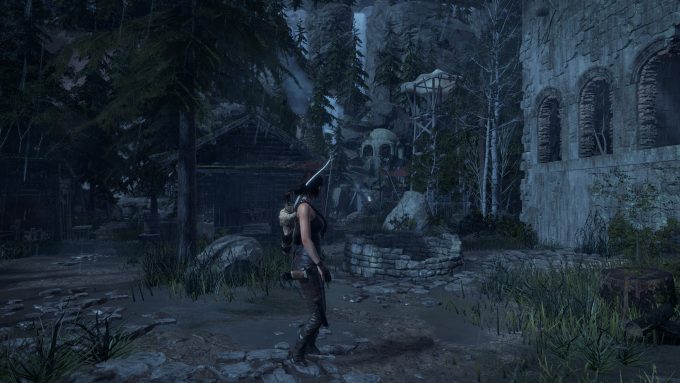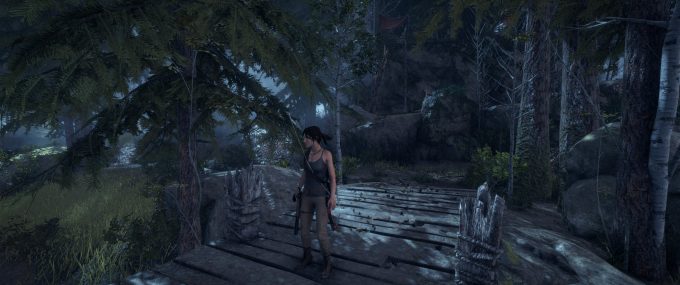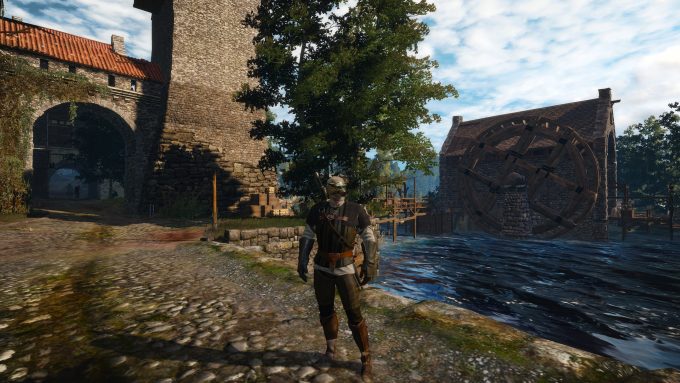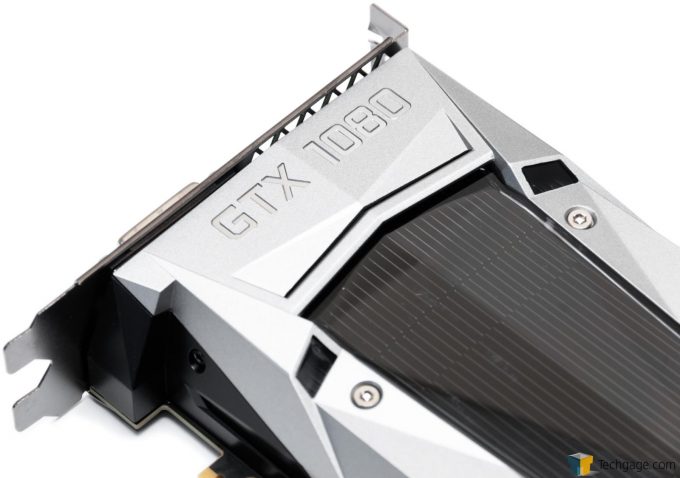- Qualcomm Launches Snapdragon 4 Gen 2 Mobile Platform
- AMD Launches Ryzen PRO 7000 Series Mobile & Desktop Platform
- Intel Launches Sleek Single-Slot Arc Pro A60 Workstation Graphics Card
- NVIDIA Announces Latest Ada Lovelace Additions: GeForce RTX 4060 Ti & RTX 4060
- Maxon Redshift With AMD Radeon GPU Rendering Support Now Available
NVIDIA GeForce GTX 1080 Overclocking & Best Playable Settings At 4K & Ultrawide

It’s no secret that NVIDIA’s new GeForce GTX 1080 is the fastest single-GPU card on the planet, but what can it do exactly? That’s what we’re going to find out, as we take the top-end Pascal card through the paces in overclocking, and then find its ‘Best Playable’ settings across a handful of games at both 4K and ultrawide resolutions.
I took an in-depth look at NVIDIA’s GeForce GTX 1080 a couple of weeks ago, and mentioned that there was more content en route. When I said that, I didn’t realize that the ever-elusive poltergeist in our lab would decide to come out and play. Thus, this article (and the others) are late; but better late than never, right?
In case you’re not familiar with this article format, it’s where we take the latest GPU and try our hand at figuring out the best settings to be used in a handful of games at appropriate resolutions, and then seek out the best possible stable overclock for the card (we’re talking undeniably 100% stable).
With that, this article has been a long time coming, so let’s just get on with it:
Our GTX 1080 Overclock
I am not even sure where to begin. When I produced this kind of article for the GTX 970 & 980, GTX 980 Ti, and GTX TITAN X, I didn’t have to fuss that much to achieve an overclock that was as stable as it was impressive. I encountered the opposite kind of ease when tackling overclocking on the GTX 1080, however.
I could dedicate an entire page outlining all of the nonsensical hassle I ran into, but for the sake of time and the desire to not bore you to death, I’ll abbreviate things here.
At first, I felt like +200MHz core and +400MHz memory was stable, as all tests I ran on these settings proved hassle-free. Those settings even managed to allow Metro Last Light Redux‘s timedemo to run at 3440×1440 / Very High 25 times over without any variation in the framerate. Imagine my surprise, then, when a day later, those same settings cut the performance advantage in half.
After much painstaking trial and error, it became clear to me that the pre-release EVGA Precision software we were provided was not ready for prime time – something we were warned about. Even so, the software caused me two definitive issues during testing: saving profiles was broken, and sometimes, new settings wouldn’t actually apply even though it appeared that they did.
Near the end of this personal debacle, I couldn’t for the life of me achieve the +200MHz / +400MHz overclock again; however, I did manage to get almost the exact same performance using +150MHz / +400MHz. Makes no sense, right? Exactly!
Despite that, I retained those settings (seen in the screenshot above) for the sake of testing. However, because of the amount of hassle encountered, I don’t at all feel confident that this is the perfect, or even an accurate overclock. It does however give us a gain of about 10%, which is in line with what we saw from NVIDIA’s Maxwell chips.
A couple of days ago, EVGA released the final version of its Precision XOC software, versioned 6.0.0. Installing this with a non-EVGA card turned out to be fruitless, as the software simply wouldn’t open. My hopes were heightened when I saw that a follow-up version, 6.0.1, was released, but again, the software simply refused to open. Thus, I had to use the seriously buggy ‘alpha’ build for overclocking here.
As ridiculous as this might sound: take these results with a grain of salt. For what it’s worth, using GPU-Z to monitor clocks during game tests peaked the card at around 2,000MHz. In previous tests, I hit 2,062MHz, but I haven’t been able to match that again.
This all said, I am confident that an overclock which could deliver a ~10% boost to performance will be possible for most users of a stock-clocked GTX 1080. This is based on the fact that similar gains were seen on Maxwell, and also the fact that colleagues have achieved similar gains (but with less hassle).
With that all said, let’s get into some performance testing, shall we?
| Stock | Overclock | Gain (Avg) | |||
| 4K (3840×2160) | Min | Avg | Min | Avg | + / – |
| 3DMark Ultra Score | 5074 | 5575 | +10% | ||
| Ashes of the Singularity | 50.8 | 56.2 | +11% | ||
| Catzilla 4K Score | 7328 | 7966 | +9% | ||
| DOOM | 41 | 52 | 43 | 52 | +0% |
| Grand Theft Auto V | 50 | 67 | 54 | 73 | +9% |
| Metro Last Light Redux | 12 | 21 | 13 | 23 | +10% |
| Rise of the Tomb Raider | 38 | 43 | 42 | 47 | +9% |
| The Witcher 3 | 38 | 44 | 41 | 48 | +9% |
| Unigine Heaven | 18 | 32 | 20 | 35 | +9% |
| Total War: ATTILA | 27 | 36 | 30 | 40 | +11% |
Across all of the titles tested, the gains in performance ranged between 9% and 11%. Unless of course we count DOOM, which somehow didn’t exhibit an increase at all. While my overclocking hassles were frustrating, I am confident that end-users should have a much easier time clocking their card to match these results, or perhaps even surpass them.
Once the overclocking situation stabilizes a bit, and other AIBs release their respective overclocking tools, I’ll give those a try and see if I can push the performance even further.
GTX 1080 Best Playable Settings (4K & Ultra-wide)
As I’ve done in previous dedicated articles and select graphics card reviews, I took a handful of games from our test suite, adjusted their settings to get as close to 60 FPS average as possible, and then took a screenshot to show you exactly what you can expect to see if you choose to pick up a GTX 1080.
An obvious caveat to this sort of testing is that not everyone’s tastes are the same. While I might be willing to drop ambient occlusion in favor of increased effects detail, you may not. In reality, it’s impossible to cater to everyone here, so these Best Playable results, like all of our others, are here just to act as a baseline; to give you an idea of what to expect. While 4K might be the new big thing, it’s ultrawide that will likely deliver better results (check out our review of the Acer Predator X34 for a look at Ultrawide in action).
Battlefield 4
This title might be getting a little long in the tooth where pushing the GPU hard is concerned, but it’s still a very popular game and hasn’t been replaced by a newer Battlefield title (worth replacing it with) up to this point. Plus, as the result below highlights, the game is still harsh on a GPU at 4K resolution.
| Battlefield 4 – 4K | |||
| Minimum | Average | ||
| 53 | 63 | ||
| Resolution: | 3840 x 2160 | Texture Quality: | Ultra |
| Texture Filtering: | Ultra | Lighting: | High |
| Effects: | High | Post Processing: | High |
| Mesh: | Ultra | Terrain: | Ultra |
| Terrain Decoration: | Ultra | Anti-aliasing Deferred: | 4x MSAA |
| Anti-aliasing Post: | Medium | Ambient Occlusion: | HBAO |
In order to breach the 60 FPS mark with this title, I had to reduce a couple of the settings from Ultra to High, and anti-aliasing post from High to Medium. The result is still quite good, and gives us a hint that Battlefield 1 could make it quite difficult to hit 60 FPS on this graphics card at 4K (assuming it’s been adequately upgraded).
| Battlefield 4 – Ultrawide | |||
| Minimum | Average | ||
| 61 | 83 | ||
| Resolution: | 3440 x 1440 | Texture Quality: | Ultra |
| Texture Filtering: | Ultra | Lighting: | Ultra |
| Effects: | Ultra | Post Processing: | Ultra |
| Mesh: | Ultra | Terrain: | Ultra |
| Terrain Decoration: | Ultra | Anti-aliasing Deferred: | 4x MSAA |
| Anti-aliasing Post: | High | Ambient Occlusion: | HBAO |
As you’ll see with all of our tests, the ultrawide resolution of 3440×1440 is much easier on the GPU than 4K. In Battlefield 4‘s case, that means that the game’s max settings can be used without a tweak. While the 4K resolution had to be decreased in order to achieve 63 FPS average, the higher settings at the ultrawide resolution gave us a 61 FPS minimum.
Crysis 3
Like Battlefield 4, Crysis 3 is another aging title in our stable. Despite that, it still pushes top-end GPUs hard, evidenced by the fact that we can’t even use Very High detail all-around at 4K with a card like the GTX 1080. That GPU strain isn’t for nothing, either; at top detail, this game is still gorgeous.
| Crysis 3 – 4K | |||
| Minimum | Average | ||
| 45 | 61 | ||
| Resolution: | 3840 x 2160 | Anti-aliasing: | FXAA |
| Texture: | High | Effects: | High |
| Object: | High | Particles: | High |
| Post Processing: | High | Shading: | High |
| Shadows: | High | Water: | High |
| Anisotropic Filtering: | x16 | Motion Blur: | Medium |
| Lens Flares: | Yes | ||
This result happened to be pulled straight out of our in-depth look at the GTX 1080, as it delivers the level of performance needed for our Best Playable section. The minimum FPS leaves a bit to be desired, largely because of all of the graphical effects that occur during the battle in this particular scene. In most cases, you won’t notice the frame drop too much as you’ll be trying to stay alive.
| Crysis 3 – Ultrawide | |||
| Minimum | Average | ||
| 48 | 64 | ||
| Resolution: | 3440 x 1440 | Anti-aliasing: | FXAA |
| Texture: | Very High | Effects: | Very High |
| Object: | Very High | Particles: | High |
| Post Processing: | High | Shading: | Very High |
| Shadows: | Very High | Water: | Very High |
| Anisotropic Filtering: | x16 | Motion Blur: | Medium |
| Lens Flares: | Yes | ||
At the top-dog ultrawide resolution of 3440×1440, Very High detail was able to be used on the most important settings, while High was left in tact for a few others.
DOOM
If you took even a quick glance at the overclocking section above, you’ll know that I encountered some nonsense that just can’t be explained. Well, DOOM gave me a similar experience. When benchmarked at High and Medium at 4K, I get roughly the same result. Makes no sense, right? Exactly! (Sorry, it felt appropriate to do that a second time.)
| DOOM – 4K | |||
| Minimum | Average | ||
| 42 | 52 | ||
| Resolution: | 3840 x 2160 | Anti-Aliasing: | TSSAA 8TX |
| Overall Quality: | High | Lights Quality: | High |
| Shadows Quality: | High | Player Self-Shadow: | Yes |
| Directional Occlusion: | High | Decal Quality: | High |
| Decal Filtering: | 4x | Virtual Texture Size: | High |
| Reflections Quality: | High | Particles Quality: | High |
| Compute Shaders: | Yes | Motion Blur: | High |
| Depth of Field: | Yes | Depth of Field AA: | Yes |
| HDR Bloom: | Yes | Lens Flare: | Yes |
| Lens Dirt: | Yes | Sharpening: | 2.0 |
| Film Grain: | 1.0 | UI Opacity | 100% |
If there’s an upside to not hitting 60 FPS here (which would require a Low overall setting), I would personally consider 42~52 FPS to be totally playable; at least, I never felt like the game was running any slower than 60 FPS outside of the battles (but as mentioned before, you’re not likely to notice a frame drop when you are trying to stay alive.)
| DOOM – Ultrawide | |||
| Minimum | Average | ||
| 50 | 66 | ||
| Resolution: | 3440 x 1440 | Anti-Aliasing: | TSSAA 8TX |
| Overall Quality: | Ultra | Lights Quality: | Ultra |
| Shadows Quality: | Ultra | Player Self-Shadow: | Yes |
| Directional Occlusion: | High | Decal Quality: | Ultra |
| Decal Filtering: | 8x | Virtual Texture Size: | Ultra |
| Reflections Quality: | Ultra | Particles Quality: | Ultra |
| Compute Shaders: | Yes | Motion Blur: | Ultra |
| Depth of Field: | Yes | Depth of Field AA: | Yes |
| HDR Bloom: | Yes | Lens Flare: | Yes |
| Lens Dirt: | Yes | Sharpening: | 2.0 |
| Film Grain: | 1.0 | UI Opacity | 100% |
Continuing tradition, the ultrawide resolution allows the game to run at very high settings, which includes a healthy serving of Ultra and most dials maxed out.
Grand Theft Auto V
While there’s no denying that GTA V is a great game, what might not be so much fun is tweaking the graphics settings. There’s just so many of them, so finding a sweet spot can be a little challenging. However, because the GTX 1080 is such a powerful card, it actually wasn’t that difficult to find Best Playable settings here.
| Grand Theft Auto V – 4K | |||
| Minimum | Average | ||
| 50 | 66 | ||
| Resolution: | 3840 x 2160 | FXAA: | On |
| MSAA: | Off | NVIDIA TXAA: | Off |
| Population Density: | 100% | Population Variety: | 100% |
| Distance Scaling: | 100% | Texture Quality: | Very High |
| Shader Quality: | Very High | Shadow Quality: | Very High |
| Reflection Quality: | Very High | Reflection MSAA: | x4 |
| Water Quality: | Very High | Particles Quality: | Very High |
| Grass Quality: | Very High | Soft Shadows: | Soft |
| Post FX: | Very High | Motion Blur: | 0% |
| DoF Effects: | Off | Anisotropic Filtering: | 16x |
| Ambient Occlusion: | High | Tessellation: | High |
For the most part, I’d almost consider this “max detail”, but there are a couple of dials that had to be turned down, such as anti-aliasing, depth of field effects, and NVIDIA TXAA. This assortment of settings delivers performance that doesn’t dip below 50 FPS, and averages 66 FPS.
| Grand Theft Auto V – Ultrawide | |||
| Minimum | Average | ||
| 50 | 67 | ||
| Resolution: | 3440 x 1440 | FXAA: | On |
| MSAA: | x2 | NVIDIA TXAA: | On |
| Population Density: | 100% | Population Variety: | 100% |
| Distance Scaling: | 100% | Texture Quality: | Very High |
| Shader Quality: | Very High | Shadow Quality: | Very High |
| Reflection Quality: | Very High | Reflection MSAA: | x4 |
| Water Quality: | Very High | Particles Quality: | Very High |
| Grass Quality: | Very High | Soft Shadows: | Softer |
| Post FX: | Very High | Motion Blur: | 0% |
| DoF Effects: | On | Anisotropic Filtering: | 16x |
| Ambient Occlusion: | High | Tessellation: | High |
Compared to the 4K resolution, the ultrawide best playable settings add MSAA, TXAA, depth of field effects, and improves the shadows – and manages to give us an extra 1 FPS on top.
Rise of the Tomb Raider
If you’re looking for a modern game that will please your eyeballs, Rise of the Tomb Raider can help with that. That is, at least, if you have the GPU horsepower to back the game’s demands up. At 4K, you’re going to be needing a lot of GPU juice at the ready, unless you’re willing to see a whole lot of ‘Medium’.
| Rise of the Tomb Raider – 4K | |||
| Minimum | Average | ||
| 55 | 62 | ||
| Resolution: | 3840 x 2160 | Texture Quality: | High |
| Anisotropic Filtering: | 16x | Shadow Quality: | Medium |
| Sun Soft Shadows: | On | Ambient Occlusion: | Off |
| Depth of Field: | Off | Level of Detail: | High |
| Tessellation: | On | SS Reflections: | Off |
| Specular Reflection: | Normal | Dynamic Foliage: | Medium |
| Bloom: | On | Vignette Blur: | On |
| Motion Blur: | Off | Purehair: | Off |
| Lens Flares: | On | Screen Effects: | On |
| Film Grain: | On | ||
I’m not sure how this game scales with SLI, but I hope it scales well, because at 4K, you’d want dual GPUs to power the game at high detail. Despite the moderate settings, the screenshot here can attest that the game will still look great, so maybe you can overlook that second GPU?
| Rise of the Tomb Raider – Ultrawide | |||
| Minimum | Average | ||
| 55 | 62 | ||
| Resolution: | 3440 x 1440 | Texture Quality: | Very High |
| Anisotropic Filtering: | 16x | Shadow Quality: | Very High |
| Sun Soft Shadows: | Very High | Ambient Occlusion: | On |
| Depth of Field: | On | Level of Detail: | Very High |
| Tessellation: | On | SS Reflections: | On |
| Specular Reflection: | Very High | Dynamic Foliage: | High |
| Bloom: | On | Vignette Blur: | On |
| Motion Blur: | On | Purehair: | Off |
| Lens Flares: | On | Screen Effects: | On |
| Film Grain: | On | ||
Yet again, the difference in settings allowed between 4K and ultrawide is great. While 4K had to settle with moderate settings, 3440×1440 allows the game to run with full detail levels.
The Witcher 3: Wild Hunt
I said that Rise of the Tomb Raider is one of the best-looking games out there right now, but I’d have to slot it in behind The Witcher 3: Wild Hunt. The game is jam-packed with eye candy, and a truly vast world to explore. At high-resolution, it’s downright gorgeous.
| The Witcher 3: Wild Hunt – 4K | |||
| Minimum | Average | ||
| 54 | 64 | ||
| Resolution: | 3840 x 2160 | NVIDIA HairWorks: | Off |
| NVIDIA HairWorks AA: | Off | NVIDIA HairWorks Preset: | Off |
| Number of BG Chars: | Medium | Shadow Quality: | Medium |
| Terrain Quality: | Medium | Water Quality: | Medium |
| Foliage Visibility: | Medium | Detail Level: | Medium |
| Motion Blur: | On | Blur: | On |
| Anti-aliasing: | On | Bloom: | On |
| Sharpening: | Low | Ambient Occlusion: | None |
| Depth of Field: | Off | Chromatic Aberration: | Off |
| Vignetting: | On | Light Shafts: | Off |
As with RotTR, The Witcher 3 will need Medium settings across the board in order to run smoothly at 4K with the GTX 1080. That’s really impressive when you think about it, considering the fact that the 1080 is the fastest single-GPU solution going right now.
| The Witcher 3: Wild Hunt – Ultrawide | |||
| Minimum | Average | ||
| 56 | 64 | ||
| Resolution: | 3440 x 1440 | NVIDIA HairWorks: | On |
| NVIDIA HairWorks AA: | 4 | NVIDIA HairWorks Preset: | High |
| Number of BG Chars: | Ultra | Shadow Quality: | Ultra |
| Terrain Quality: | Ultra | Water Quality: | Ultra |
| Grass Density: | Ultra | Texture Quality: | Ultra |
| Foliage Visibility: | Ultra | Detail Level: | Ultra |
| Motion Blur: | On | Blur: | On |
| Anti-aliasing: | On | Bloom: | On |
| Sharpening: | High | Ambient Occlusion: | SSAO+ |
| Depth of Field: | On | Chromatic Aberration: | On |
| Vignetting: | On | Light Shafts: | On |
It’s probably safe to say that the GTX 1080 is the ‘ultimate’ card for Wild Hunt at 3440×1440, as almost everything can be maxed out without worry. The exceptions to speak of is that HairWorks maxed-out was chosen in favor of HBAO+ (which was knocked down to SSAO). In my opinion (and the opinion of a few others on the Techgage team), HairWorks adds a lot more to the game than a bump from SSAO to HBAO+ does.
Final Thoughts
What can we take away from this long page? For starters, while I had a ridiculous time overclocking the card, you’ll be able to avoid the same issues I did. However, what I am not confident about are the clocks that I provided, because while the application (EVGA Precision) shows +150MHz Core and +400MHz Memory, hassles incurred during testing make me believe I could have achieved the same exact real performance with different settings. Once I get more stable overclocking software, I’ll be able to verify this.
Nonetheless, as we saw with the top-flight Maxwell cards, you can see at least a ~10% improvement in performance when clocking a GTX 1080 beyond NVIDIA’s stock speeds. As mentioned earlier, my real top limit was around 2,000MHz. NVIDIA has told me this level of boost is expected when overclocking, although dedicated clockers are likely to push the card even higher.
As for the Best Playable results? The GTX 1080 isn’t a “4K card” like many were hoping, which isn’t an insult to the card but rather a testament to just how hardcore that resolution is. It’s also a reason I think folks should consider a 3440×1440 ultrawide monitor, because it’s not just able to provide a wider view of your games, it can run a lot faster, as well.
None of this is much of a surprise thanks to simple math: ultrawide is 21:9, not 16:9 (like 4K, 1080p), and it’s just 5 megapixels, not 8. As seen in the above performance results, some games that couldn’t go beyond Medium settings in games at 4K could be pushed to Very High at 3440×1440 thanks to the drop in megapixels.
At the end of the day, you have to choose between a resolution that’s far more demanding on a GPU at the same aspect ratio of most of the monitors on the market today, or opt for a wider resolution that happens to be a lot easier on the GPU.
Whatever you choose, the GTX 1080 is one hell of a card, and at this point, the only thing we want to see is how AMD’s Polaris is going to compare. The first Polaris cards are rumored to launch at the end of June, so our wait for the answers to our questions won’t take much longer to get here.
It’s going to be a fun summer!
Support our efforts! With ad revenue at an all-time low for written websites, we're relying more than ever on reader support to help us continue putting so much effort into this type of content. You can support us by becoming a Patron, or by using our Amazon shopping affiliate links listed through our articles. Thanks for your support!




